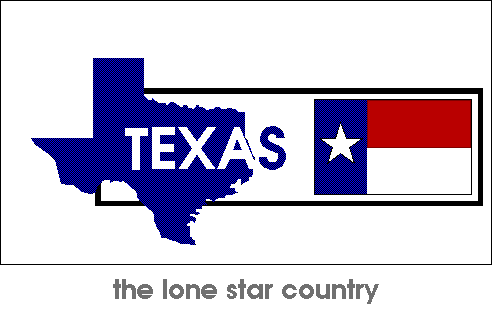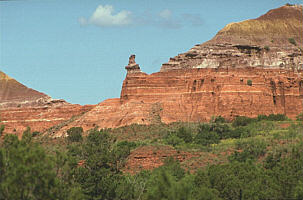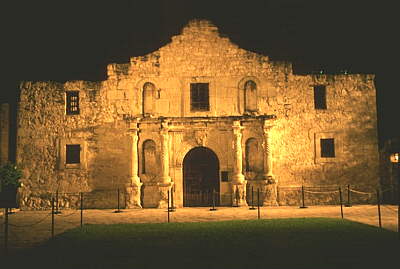




In July 1992 I visited Texas during a tour throughout the Southern US. Most impressing
were the diverse landscape (swamps on the Gulf of Mexico, hundreds of lakes in the North,
desert in the West) and the very friendly people. Texans are very proud of their history and
their achievements in this century. (Often the Texans reminded me of the Bavarians.) Texas
belongs to the leading US states in business and technology. The Apollo moon landings for
example were controlled from the Johnson Space Center, Houston. Every 20th Texan is of German
extraction.


| Nickname | The Lone Star State |
| Motto | Friendship |
| Flower | Bluebonnet (Buffalo Clover, Wolf Flower) |
| Bird | Mockingbird |
| Tree | Pecan |
| Song | Texas, Our Texas |
| Stone | Petrified Palmwood |
| Gem | Texas Blue Topaz |
| Grass | Side Oats Grama |
| Dish | Chili |
| Seashell | Lightning Whelk |
| Fish | Guadalape Bass |
| Entered the Union | December 29, 1845 |
| Capital | Austin |
| Land Area (square miles) | 261,914 |
| Rank in Nation | 3rd |
| Density per square mile | 64.86 |
| 1992 Estimated Population | 17,656,000 |
| Number of Representatives in Congress |
27 |
| Rank in State | 5th |
| Largest City | Houston: 1,630,553 |
| Number of Places over 10,000 Population |
182 |
| Source: The Book of the States, 1992-93 edition, Vol. 29 The Council of State Governments, Lexington, KY. |

The first Spaniard, Cabeza de Vaca, landed on the Texas coast in 1528. In the mid 1500s the Spanish searched for gold in the area now known as Texas. The first town was Ysleta founded in 1685.
The Spanish word 'Tejas' (='friendly') stems from the name of a confederacy of local Indian tribes (and friendly the Texans really are !!).
French penetration into the area led to the establishment of more Spanish missions in the south-central area: Goliad, Nacogdoches and San Antonio (see below).
Till the 19th century Texas was sparsely settled, although colonization by the Spanish was enforced in the middle of the 1700s. A short-lived First Republic of Texas was declared by Americans in San Antonio on April 6, 1813, but it collapsed soon.
In 1821 the US dropped all claims toward Texas in the Transcontinental treaty with Spain in return for cession of Florida.
When Mexico (which then included Texas) became independent from Spain in the 1820s, the Mexican government reinforced populating the province and invited American settlers to Texas. The primary incentive was Mexico's offer to sell Americans settlers 4,400 acres of land for only 200 USD. (Mexico demanded that the American settlers held no slaves.)
Moses Austin, who later became a key figure in the Texas Revolution of 1835, led 300 families to Texas.
In just a decade Americans (15,000 in 1830) outnumbered the Mexican population, so the Mexicans shut down all state legislatures, ruled Texas from Mexico City, and sent forces into the province.
The American Texans started an independence war in 1835, which was largely financed by the US government. Famous became the siege of the Alamo, a former mission in San Antonio, by the Mexican troops. 187 Americans held the mission (although no order was given) against the Mexicans and all but 2 were killed. Today the Alamo is also known as 'The Shrine of Texas Liberty' and is worth visiting.

Annexation was achieved by a simple majority vote in Congress which was unprecedented because US constitution demanded a two-thirds Senate vote which at that time was unobtainable. So Texas became a US state on December 29, 1845 by only a 27 to 25 margin in the Senate.
Texas seceded in 1861 and rejoined the Union in 1870.

This is the most beautiful city I have ever seen. See pictures below.

| Population | 935,900; metro 1,072,000 (1992 figures) |
| Altitude | 650 ft. |
| Area Code | 512 |
| Visitor Information | The San Antonio Convention & Visitors Bureau 317 Alamo Plaza, TX 78205, phone: (512) 270-8748 |

San Antonio, with its old Spanish flavor, multicultural populace, and many parks and plazas, is one of the more picturesque American cities. Modern skyscrapers coexist harmoniously with 18th-century restorations. Since most of downtown was built before 1930, the architectural mixture is as varied as periods and materials allowed. Alamo-style rooflines mix with seashell-ornamented commercial buildings and cream-colored stucco structures with red tile roofs.
The site that was to become San Antonio was a Coahuiltecan Indian village when a Franciscan mission, San Antonio de Valero [named after the then Spanish viceroy of Mexico, Marquis de Valero], and its protecting fort were built in 1718. The mission to convert [...] the Indians was renamed the Alamo [a century later], from the Spanish word for 'cotton tree'. Four other missions were soon established but a civil settlement only began in 1731. [...]
In 1794 the missions were secularized, the buildings abandoned, and the cultivated lands reverted to the former owners.
Once the capital of the Spanish province of Texas, the area was won by the Mexicans from the Spanish during the Mexican Revolution in 1821. Stephen F. Austin arrived in San Antonio in August of that year and negotiated a plan with the Mexican government by which 300 US families were allowed to establish themselves in Texas. Although until 1836 San Antonio was the scene of continuous struggle, the Anglo-Saxon population in the area grew to more than 35,000.
The Alamo became the cradle of Texas liberty when its 187 defenders valiantly fought to the death against the 5,000-man army under Gen. Antonio Lopez de Santa Ana. The tragic heroism of the Alamo defenders bought time for Sam Houston's army and their sacrifice inspired the cry 'Remember the Alamo !' which spurred Houston's Texans to their decisive victory at San Jacinto.
After the battle at the Alamo the area was abandoned until the 1840s, when German immigrants resettled San Antonio. So dominant was their influence that for a time street signs appeared in Spanish, English and German. [...]
Education, a legacy of the Franciscans, thrives in San Antonio. Among the many institutions of higher learning are St. Mary's University, Trinity University, Incarnate Word, and Our Lady of the Lake and the University of Texas at San Antonio.
The San Antonio River makes a 15-mile horseshoe loop through 6 miles of downtown city blocks. The river symbolizes the beauty and romance of the city and the homesickness felt by those who have left it:
While sampling its waters is no longer recommended, visitors will be drawn back to the Riverwalk, or Paseo del Rio. A tree-lined footpath, romantically lighted at night, follows along the riverbanks, which are landscaped with lush tropical foliage and bordered by nightspots, restaurants and shops.
(Taken from Texas Tourbook by the American Automobile Association, 1992 edition, p. 90f.)






Mean resolution of the images is 730x500 pixels.

Tour Book Texas by the American Automobile Association, price: unknown
Contains information on history, economy, geography, recreation and plenty of touring tips.
Texas State Travel Guide by Texas Department of Transportation, Austin; price: free (at least till 1992)
Description of mostly all Texan towns.
The Smithsonian Guide to Historic America, Texas and the Arkansas River Valley by A. Gordon, J. C. Dunn, M. White; Steward, Tabori & Chang, New York; price: USD 18.95
The bible for tourists interested in historical sites of Texas, Arkansas and Oklahoma, containing information on Texan history from 1519 through the late 19th century.
The American Age - US foreign policy at home and abroad, 1750 to the present 2nd Ed. by Walter LaFeber; W W Norton & Company NY/London; price: ?
Features information of US policy towards Texas (one of the most interesting book I have read).
Author and responsibility:
Alexander F. Walz, Düsseldorf, Federal Republic of Germany.